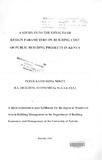| dc.description.abstract | This study looks at the effect of design parameters on building cost of public building
projects in Kenya. Four elements have been selected for examination. The four elements are
substructure, walling, roofing and finishes. The study has established that design parameters can be
used to express building cost by elements and therefore can be used in cost advise in the early stages
of design process. The design parameters considered in the study are size, storey height, total
height, shape and specification and building cost index.
Both correlation and regression analyses were used to test the strength of the relationships
between the cost of buildings by elements and the design parameters.
A total of forty three buildings qualified for study out of a population of two hundred and
eighteen.
Substructure exhibited strong correlation coefficient of 0.7295 with size of building at
student t-test confidence level of 99'%. Roofing showed correlation coefficient level of 0.600 with
building cost index and finishes recorded 0.5318 with size of building.
The regression analyses showed even better results by including several design parameters
in the equation. Substructure was better explained by size, building cost index and storey height,
achieving a multiple correlation of 0.800. Similarly walling was explained by size and storey height
giving a multiple correlation coefficient of 0.716. Roofing was explained by building cost index
and storey height giving a multiple correlation coefficient of 0.69 and finishes was explained by
size, storey height and building cost index giving a multiple correlation coefficient of 0.65.
In determining which design parameter to include in the element cost equation, stepwise
regression was used. Only those design parameters, which satisfied the criteria for selection using
stepwise regression was included thus rninimising the standard error and increasing the strength of
the relationships.
The findings of this study show that building cost can be explained by their elements and the
design parameters that affect the cost of the elements. In so doing vital information during design
stage can be accessed in order to keep to the budget limits given by clients.
This study is divided into five chapters.
The first chapter o~ this study outlines the evolution of cost models in the evaluation of
building costs over time, where we find traditional models being blamed for not controlling building
cost. This problem can reasonably be reversed by introducing the concept of design parameters in
the estimation of building costs at early design stages.
The second chapter looks at the concepts associated with implementation of public building
projects, cost control and cost planning together with design method and cost planning.
Chapter three looks at cost consequences of building elements on design parameters and the
study model. The design parameters considered are size of buildings, its shape, total height and
storey height.
Chapter four is on data analysis and presentation. It is concerned with the gathering of data,
how it was transformed for analysis and finally how it was interpreted and presented.
Finally, Chapter five covers conclusions and recommendations of the study together with
recommended areas of further research. | en |

